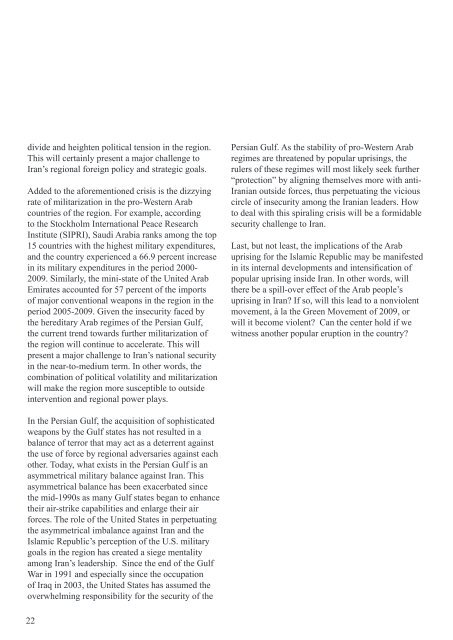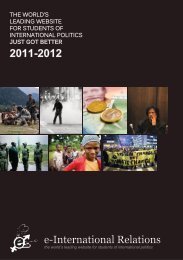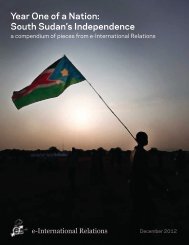The Arab Spring of Discontent - e-International Relations
The Arab Spring of Discontent - e-International Relations
The Arab Spring of Discontent - e-International Relations
You also want an ePaper? Increase the reach of your titles
YUMPU automatically turns print PDFs into web optimized ePapers that Google loves.
Cultural Emancipation & Political<br />
Liberation: <strong>The</strong> Iranian Green Movement<br />
<strong>The</strong> author wishes to have their identity withheld for security reasons<br />
divide and heighten political tension in the region.<br />
This will certainly present a major challenge to<br />
Iran’s regional foreign policy and strategic goals.<br />
Added to the aforementioned crisis is the dizzying<br />
rate <strong>of</strong> militarization in the pro-Western <strong>Arab</strong><br />
countries <strong>of</strong> the region. For example, according<br />
to the Stockholm <strong>International</strong> Peace Research<br />
Institute (SIPRI), Saudi <strong>Arab</strong>ia ranks among the top<br />
15 countries with the highest military expenditures,<br />
and the country experienced a 66.9 percent increase<br />
in its military expenditures in the period 2000-<br />
2009. Similarly, the mini-state <strong>of</strong> the United <strong>Arab</strong><br />
Emirates accounted for 57 percent <strong>of</strong> the imports<br />
<strong>of</strong> major conventional weapons in the region in the<br />
period 2005-2009. Given the insecurity faced by<br />
the hereditary <strong>Arab</strong> regimes <strong>of</strong> the Persian Gulf,<br />
the current trend towards further militarization <strong>of</strong><br />
the region will continue to accelerate. This will<br />
present a major challenge to Iran’s national security<br />
in the near-to-medium term. In other words, the<br />
combination <strong>of</strong> political volatility and militarization<br />
will make the region more susceptible to outside<br />
intervention and regional power plays.<br />
In the Persian Gulf, the acquisition <strong>of</strong> sophisticated<br />
weapons by the Gulf states has not resulted in a<br />
balance <strong>of</strong> terror that may act as a deterrent against<br />
the use <strong>of</strong> force by regional adversaries against each<br />
other. Today, what exists in the Persian Gulf is an<br />
asymmetrical military balance against Iran. This<br />
asymmetrical balance has been exacerbated since<br />
the mid-1990s as many Gulf states began to enhance<br />
their air-strike capabilities and enlarge their air<br />
forces. <strong>The</strong> role <strong>of</strong> the United States in perpetuating<br />
the asymmetrical imbalance against Iran and the<br />
Islamic Republic’s perception <strong>of</strong> the U.S. military<br />
goals in the region has created a siege mentality<br />
among Iran’s leadership. Since the end <strong>of</strong> the Gulf<br />
War in 1991 and especially since the occupation<br />
<strong>of</strong> Iraq in 2003, the United States has assumed the<br />
overwhelming responsibility for the security <strong>of</strong> the<br />
Persian Gulf. As the stability <strong>of</strong> pro-Western <strong>Arab</strong><br />
regimes are threatened by popular uprisings, the<br />
rulers <strong>of</strong> these regimes will most likely seek further<br />
“protection” by aligning themselves more with anti-<br />
Iranian outside forces, thus perpetuating the vicious<br />
circle <strong>of</strong> insecurity among the Iranian leaders. How<br />
to deal with this spiraling crisis will be a formidable<br />
security challenge to Iran.<br />
Last, but not least, the implications <strong>of</strong> the <strong>Arab</strong><br />
uprising for the Islamic Republic may be manifested<br />
in its internal developments and intensification <strong>of</strong><br />
popular uprising inside Iran. In other words, will<br />
there be a spill-over effect <strong>of</strong> the <strong>Arab</strong> people’s<br />
uprising in Iran? If so, will this lead to a nonviolent<br />
movement, à la the Green Movement <strong>of</strong> 2009, or<br />
will it become violent? Can the center hold if we<br />
witness another popular eruption in the country?<br />
While the <strong>Arab</strong> uprising is sweeping the Middle<br />
East and North Africa throughout, displacing<br />
dictatorships and defining a new dawn <strong>of</strong> democracy<br />
in the region, the Iranian Green Movement (IGM)<br />
appears to be enmeshed in a political morass.<br />
Protesters have retreated from the real public sphere<br />
and limited themselves to the less precarious haven<br />
<strong>of</strong> private corners or the more obscure sanctuary<br />
<strong>of</strong> virtual space; its recognized leaders have been<br />
detained and are kept under house arrest; the regime<br />
has been emboldened in intimidating, incarcerating<br />
or eliminating its supporters, activists and<br />
sympathizers, considerably ensured that it can do so<br />
with impunity; and above all, fierce controversies<br />
having erupted over its roadmap for progress and<br />
its central objective – revolution or reform – have<br />
reinforced divisions among its exponents, elite and<br />
grass roots alike.<br />
In such a bleak political climate, in the winter <strong>of</strong><br />
our discontent, a provocative question concerning<br />
the life and vitality <strong>of</strong> the movement may haunt<br />
many. Is it still alive and kicking or should we start<br />
a countdown <strong>of</strong> its final breaths? <strong>The</strong> doomsayer<br />
arguments indicating in one way or another the<br />
demise <strong>of</strong> the movement are not so well-grounded as<br />
to be convincing; after all, 14 February 2011 public<br />
protests represent a watershed moment in the Green<br />
struggle <strong>of</strong> Iranians for democracy and freedom.<br />
However, there is no escape from the bare reality<br />
that it does not rage unabated as it did, and is not<br />
so dynamic and defiant as it was two years ago<br />
when a peaceful protest against the massive stateorchestrated<br />
fraud in June 2009 presidential elections<br />
gave birth to it. Would the dissident reaction to the<br />
de facto detention <strong>of</strong> IGM leaders, Mousavi and<br />
Karroubi, have been so lukewarm and muted as it is<br />
now if they had been confined and cut <strong>of</strong>f the outside<br />
world in, say, a few months after the 2009 elections?<br />
To be straightforward, the answer is most probably<br />
not. We should admit that the once irreversible<br />
upward momentum <strong>of</strong> the movement has slowed at<br />
the most optimistic.<br />
Coupled with the democratic victories in Tunisia and<br />
Egypt and a likely popular triumph in Yemen, this<br />
leads us to the second haunting question that may<br />
pose itself more dauntlessly to those who harbor a<br />
racist belief in the imagined supremacy <strong>of</strong> Persians<br />
over <strong>Arab</strong>s: Why did Tunisians and Egyptians win<br />
the day before long whereas we are still muddling<br />
along through the hard times? A number <strong>of</strong> reasons<br />
and explanations have been <strong>of</strong>fered from various<br />
quarters <strong>of</strong> differing political inclinations. Many<br />
have pointed to over-securitization <strong>of</strong> the public<br />
sphere by the state security apparatus and its largescale<br />
attempts at embryonic suppression <strong>of</strong> emerging<br />
dissent; some have highlighted the relatively<br />
great resilience and high elasticity <strong>of</strong> “religious<br />
despotism” and the difficulty surmounting it; others<br />
may see the absence <strong>of</strong> a coherent strategy as well<br />
as an effective central leadership as the major reason<br />
for the failure <strong>of</strong> Green Movement to achieve its<br />
ultimate democratic aims; still others may point the<br />
finger <strong>of</strong> suspicion at the internal rifts and splits<br />
while some have gone so far as to blame foreign,<br />
and in particular Western, sympathy with the Greens<br />
for the lack <strong>of</strong> their satisfactory progress. And a<br />
final group may contend that if the movement has<br />
relatively subsided, it is a calculated move, as it does<br />
not seek revolutionary or radical action in the first<br />
place.<br />
Indeed, all these factors have worked to varying<br />
degrees and with some more plausible than others,<br />
have exerted a proportionately discernable effect<br />
upon our Green struggle for liberty and justice.<br />
Of course, this is not to paint the wider picture<br />
in absolute black and white colors and deny<br />
their potential positive aspects: If the differences<br />
within the Green Movement have favored some<br />
at the expense <strong>of</strong> others, they have also helped to<br />
pluralize and diversify it, expanding its supporter<br />
22 23







